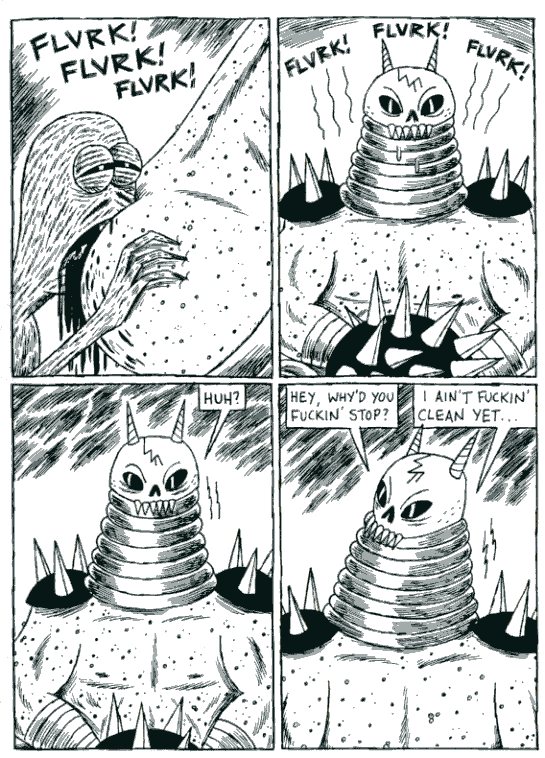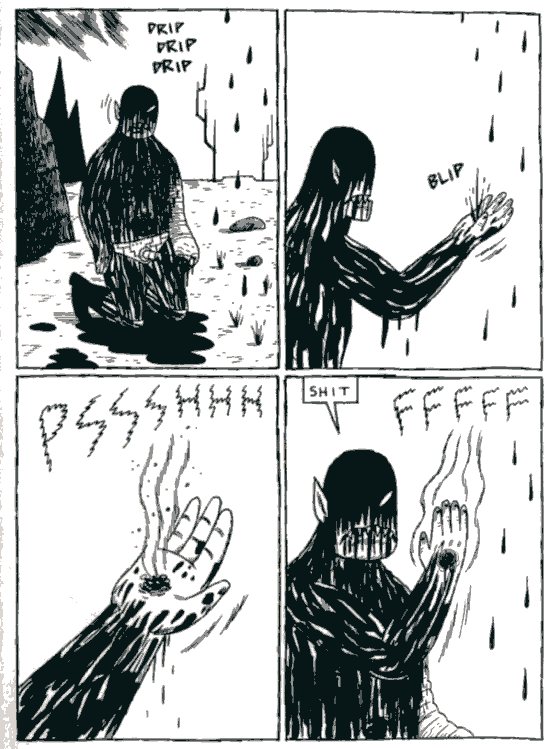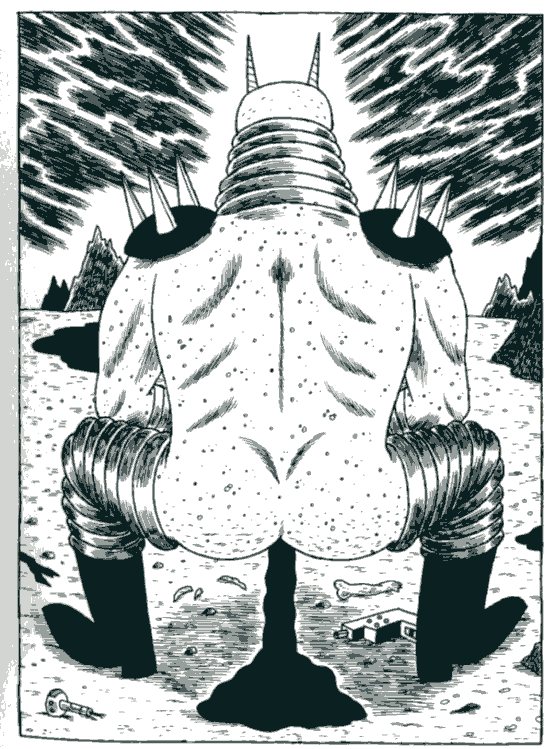Creativity is crap. Worship me, adoring public, and I will present you with a fragrant present! We will sculpt it into the head of John Stewart and he will call for stinky moderation in the lapping up of turds.
Johnny Ryan does not usually call for moderation. Where Chris Ware draws a billion tiny boxes to retain his feces, Ryan’s draws borders mostly so the sewage will have something to overflow. In Prison Pit each body is a busted toilet whose stagnant water births some mangled abortion dragging its placenta over the edge of the porcelain to flop wetly on the cold tiles. Tentacles erupt from vaginas, vomit spews from sentient arms, and dripping things that should not be tear open their mothers in an orgy of violent polymorphous ichor. Black blood drips like ink off the mechanical penis of Ryan’s protagonist and then pools in scratchy pen lines, half-formed half-assed nightmares drawn on the back of a middle-schooler’s history notebook.
The protagonist fights ladydactyls, giant eye creatures, robots, toothy monsters wearing Nazi death-hosen, and his own mutinous oozing hand. But really his main enemy is Ryan himself, the artist as diabolous ex machina, squatting over his creation to spew an endless stream of venomous diarrhea.
The prison pit where the protagonist is trapped is Ryan’s skull, which is also Ryan’s ass. Thought is scat and art is a giant festering field of dream-turds. The black first panel rubs your nose in the blank and humid stench that precedes the conception. The conceiver is God, and to prove it he makes shit. This is some of it.






So..did you like the book or not, Noah?
Of course!
The evacuation of the faeces is a necessary step for the nascent psyche to move “upwards” from the anal stage, typical of Chris Ware, in which a pleasure in the retention of faeces stymies the progression towards a mature, genital stage of development.
Thus we can interpret ‘Prison Pit’ as a signal of Johnny Ryan’s groping to maturity.
Note also that this comic is published in the financially unviable ‘floppy’ format.
This is part of Ryan’s unconscious maturation “strategy”, as it has been proved that the accumulation of money is merely an expression of the infantile psyche’s delight in faeces retention.
Unfortunately for your analysis, Prison Pit isn’t published as a floppy. It’s a nifty digest/book type thingee.
Since I mentioned God in the above, it’s worth noting that both Ware and Ryan use a demonic/Superman/God character at various points. Superego!
At least Ware has more guts than Ryan.
Nah, I don’t agree with that. It’s true Ware’s gone kind of more middle-brow, while Ryan’s definitely moving into high-brow, abstract fare with Prison Pit. But I don’t think that should be held against him.
I’m sure the Freudian stuff is intended as snide, but I have curated not one but two art shows more or less around the theme of shit and the primal father. Pooping is how men make babies. Actually, I curated a Frankenstein-themed show, which actually also sort of counts. That makes three.
Apropos of Ryan and Ware, it seems like Ware might be more of a straightforward retentive sadist, with his fixation on repetition, purity, precision, and anonymity. And Ryan ends up being a man who can only please himself by causing himself anguish through his own fear of punishment at his expulsive self-titillation.
So sure, if sadists have more guts. In this case, they’re also less fun to read any time in the last ten years.
Freud aside, I haven’t read “Prison Pit” but this looks like Johnny Ryan moving into Fort Thunder territory. More specifically, the, umm, shitting theme seems taken directly from the first piece in Brinkman’s “Teratoid Heights.”
It’s possible. There was also that guy who couldn’t stop shitting because his anus was a gateway to another dimension, in that fabulous old Chester Brown thing, Ed the Happy Clown.
I think Acme #10 is arguably more masochistic than sadistic — which might be true for Ware’s work in general. It’s the horror movie thing — you identify with the victim.
It’s hard to see Johnny as agonized exactly — the book’s just such fun. I think Andrei’s point about Fort Thunder is dead on. It just feels like creativity as celebration and assault; the gay utopia for mean-spirited 14-year old auteurs.
The art’s really beautiful too. He’s definitely broken on through there; it’s still scratchy and crude in a way, but the layouts are elegant and the character designs have a brutal warped efficacy. It’s such a great book.
No, you know, I’m willing to stand up for my counterintuitive faux-insight here. Chris Ware is a sadist. All those little whining melancholy spheres he bosses around– that gives him a sense of control and conquest. It’s the S.N.A.G. switcheroo. The guy who invents the spoof on superheroes has conquered all superheroes, and then wants to generate an infinity of them (a la the Mystery Men, Tick, Adolescent Radioactive Black Belt Hamsters, me in high school…). The sensitive male, speaking as such, is a dangerous illusion.
Whereas Johnny Ryan is constantly giggling and spewing, getting attention with his feces, while obediently actually engaging with the tropes of the comic book. He’s the mama’s boy. While Ware, as we all know, is obsessed with his (faceless) father.
I don’t think horror movie scopophilia explains everything. The true protagonist in a horror movie is so rarely a victim, which is why I Spit On Your Grave and its ilk, and even Halloween and Alien, are to be cherished.
Well, I think the point about horror movies is that the pleasure comes from the masochism and the sadism, and from switching between the two. He’s not just bossing around the spheres; he’s identifying with them. His books are definitely obsessed with sadism and masochism and with control — I don’t deny that. And I think it’s right that he’s the ogre father as well as the castrated child…but that doesn’t mean he’s not the castrated child too (in line with Freud; male identity is both/and.)
I would say that Ryan is much more interested in escaping the dynamics of control; it’s about repealing taboos, whether around scat or around boundaries. If he’s a mama’s boy, it’s not because he’s obedient to the formal demands of comics per se, but because he’s pre-Oedipal; not obsessive control, but bodies and pleasures. Prison Pit’s a kind of gay utopia, just like The Thing (there’s actually a pretty awesome Thing homage in this issue.)
I think that’s why Johnny makes sense with the Fort Thunder people — or with Edie Fake. Loose narrative with bodies fucking and falling apart and bleeding and violating each other in a surreal shifting landscape — that describes Prison Pit and Gaylord Phoenix equally well.
Or Junko Mizuno?
Just cause you’re into freedom doesn’t mean you’re not into control. Look at hippies, or Republicans. I am more or less willing to say that Chris Ware is more into watching the sad clown get abused, dumped, murdered, than he is into identifying with the sad clown. Jeffrey Brown, quite the opposite. He’s a much better-trained little hack.
The gay utopia is about mothers more than fathers, certainly– the pre-Oedipal comment makes sense. But, as Kristeva and everyone else acknowledges, there is no pre-Oedipal state that includes language, only an abject nostalgic gloom. Which yes, sounds like Ware. But I think he and Ryan may be equally insecure, and are both driven (and I mean driven) by repression.
“Pooping is how men make babies.”
We really aren’t good at it.
That last picture is really horrible.
“The Hooded Utilitarian. We give a shit.”
I think when Ware’s on his game it’s really not easy to separate the two. It’s like Kafka in that way. (And yes, there’s much less tension in Jeff Brown, which is one of a number of reasons that he’s not as interesting.)
I get your point about freedom and control…obviously opposites are about each other. I mean, do you see Edie Fake as obsessively about control? Or Ariel Schrag? They’re all pretty obsessed with bodily functions and penises… Repression just doesn’t seem like where any of them are coming from exactly — except insofar as you believe Freud that everything that’s sexual (or desired) is repressed….
Pre-Oedipal and language — Ware’s pretty fixated on language, which makes sense re the father. All the text shoved everywhere, as if it’s hiding and/or spilling out to take over. Edie Fake has text, but it ends up being part of the image; almost a design element rather than language (whereas for Ware it’s more like the design elements become language themself.) I think Prison Pit is a lot closer to Gaylord Phoenix; the characters do talk to each other, but you almost wonder why they bother…there’s also a pretty interesting sequence where the protagonist communicates silently with the slug that’s taken over his arm by touching tongues with it — a kind of eroticized one as two that sort of rhymes with Irigary’s sex that is not one.
I mean, you read Prison Pit — it’s not unlike Paul Nudd. It’s not unlike feminist performance art. (It’s also like horror films, of course — which aren’t unlike those other things, either.)
You haven’t read Prison Pit though, have you? I need to lend you my copy; it’s pretty fabulous….
““The Hooded Utilitarian. We give a shit.”
I prefer “A Pundit In Every Panoptipoop”
..poopoptican
I always want to put an umlaut in “poop,” like “cooperate.” “Pooperate.”
It’s funny, since feminine jouissance is all about talking– and men’s desire (we don’t really get jouissance) is all about stalking. These things should surely translate in some obvious way in comics, but not necessarily.
Jimmy Corrigan comics, and my favorite Chris Ware things, are not really dependent on words. Narcisssism is pretty key. Narcissism, sadism, and loneliness makes for a good serial killer. My point being, you don’t need to be a masochist to have apocalyptic legalistic pathos– either with Kafka or Ware– or Walter Benjamin, or even Karl Marx. It’s the straight dystopia.
I would say that the gay utopia really does rely on ecstatic words, and images that are so graphic as to double as symbols. Actual poetry, specific turns of language are crucial, unlike Ware or Kafka, who are more about imagery. You can’t imagine those guys having “hot rainbow-on-retard action” as a catch phrase.
I haven’t seen Prison Pit, though, just to answer that question. But I am arguing that it totally makes sense with Fort Thunder, Keith Herzik, Ariel Schrag.
Keith! I’d totally forgotten about Keith. Yes, he would love Johnny, and vice versa.
I see what you’re saying about Johnny and language vs. Ware and language. At the same time…the way Ware uses language is definitely important… I think Matthias was talking about how Ware seems to convert imagery into language, or that he sometimes argues that that’s what he’s trying to do. That fits with control in some ways I think; there’s a way or a sense in which language is more delimited, perhaps, more controllable. Images are less defined, more about evocation than meaning. Ware seems sometimes to be trying to squeeze the evocation out of imagery, to control it so tightly that all that’s left is a word he speaks. Not that his stuff isn’t evocative, but it ends up being the evocativeness that’s wrung out of it. Shaenon Garrity commented once that a Ware comic made her cry not because of its content, but because the technique was so overwhelming; the pathos was in imagining the beauty of creating something like that.
With Johnny the various bits of language really do function as images; I mean, they sort of advance the story, such as it is, but they’re more just surreal/vile/funny jokes — words as images.
Language (the symbolic) is utterly unstable; images (the imaginary) have a far more solid claim on the “real.” They’re almost too “real” for capitalism, which runs on information but proliferates and immediately disposes of images as shit, as meaningless litter.
This may seem like a subtle distinction because, well, it is, unless it’s just horsehit. Regardless, words becoming images in Ware (“AND,” “THEN,” etc.), and images becoming words in Fake (uniforms bearing slogans “Up In Your Arms” and “Up In Your Arms”) are, I think, significantly different maneuvers. The words are decorated by the uniforms, they add to the meaning, for Fake; the words for Ware are absurd, they interrupt the nonsense death-chant of visual repetition with a brief reminder of verbal nonsense.
I would argue that the proliferation of poetic language almost makes the endless boundary-hopping of gender in Shakespeare a virtual necessity.
Yeah, I agree; they’re opposite moves.
Isn’t language about trying to get control of the real, though? I thought that was sort of the point of Lacan, at least to some extent — the symbolic as mastery. Which is why I’m seeing Ware as trying to turn images into language — not an interruption, but part of what he does with the images too (which is kind of trying to turn them into pictographs, a kind of language.) Whereas for Fake the words/stencils become part of the picture, words falling into images. Maybe?
It’s hard to tell with manga…but I think there’s more integration of the words as pictorial elements there, or at least that’s my impression….
The unconscious is structured like a language (and vice-versa), is probably the glibbest Lacan summary I have on hand. It’s deeply connected to desire, but it also refers/defers endlessly–just like our desires. Repression thus certainly has a relationship to language, and thus mastery (of one’s bowels), but it’s hardly an expressive relationship. Quite the opposite.
I think the horro vacuii in Ware also has a relationship to sadism and repetition, and his use of language as meaningless icons, but that might be another discussion.
my problem with prison pit is that ryan is trying too hard to be offensive, the book just isn’t offensive, it’s way too obvious. Like this book would offend my mom and my grandma, but it’s just too goofy to be offensive to someone willing to engage. the style that he’s taken up with the “scratchy” line is pretty contrived from fort thunder, his gag style was so neat, it just doesn’t make sense. i don’t see this book holding up in the future like power mastrs or any of chippendale’s recent output. All i see when i read prison pit is someone trying to force themselves into a current popular underground style, but the work is so boring that it maintains some kind of mainstream appeal.
Yeah, I pretty much disagree with all of that. I think the drawing is beautiful — it’s obviously partly Fort Thunder, but it’s also derived from horror manga, I think, and it really does look like kid’s art too in a way I really dig.
And I don’t think it’s right to say he’s trying to be offensive exactly. The goofiness is a big part of the charm; it’s surreal and weird and unexpected. To me it’s not boring at all. Not gag-based, obviously, but bizarre and really consistently entertaining in its dada surrealism. But mileage differs, of course.